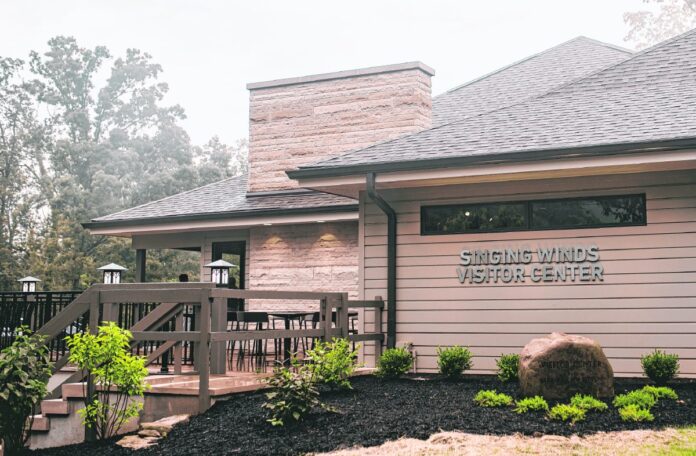BELMONT — Visitors to T.C. Steele State Historic Site now have several new attractions to explore, thanks to donations from local people, Friends of T.C. Steele, grants and the State of Indiana.
A 4,600-square-foot Singing Winds Visitor Center opened June 15. Ground had been broken in September 2017.
The two-story visitor center, built into a hillside between the Steele home and the pit toilets, includes indoor restrooms, programming space, a gift shop, and a space to watch a video introduction to the site’s history, among other amenities.
[sc:text-divider text-divider-title=”Story continues below gallery” ]At age 60, Theodore Steele, an impressionist painter, moved to the wooded, abandoned farm on the western edge of Brown County from the city with hopes of becoming a recluse, with his new bride, age 37.
While living at the property from 1907 to 1926, Steele produced a body of work that not only caught the attention of other city artists longing for a more serene setting, but also propelled him into national recognition as a landscape and portrait painter.
Steele is credited with starting the movement that molded Brown County into the Art Colony of the Midwest.
At various locations around the 200-plus-acre historic site, visitors can explore the real locations that inspired specific Steele paintings and engage in interactive activities that highlight Steele’s artistic process.
Families also can visit T.C.’s Outdoor Studio, featuring a wagon modeled after Steele’s traveling studio. There, adults and children can create art, play games, put themselves into famous works of art and more, says a press release from the Indiana State Museum and Historic Sites.
The large studio will feature a new rotation of Steele’s work in an updated gallery space, as well as activities for families, and a chance to see how a plein air painting comes together.
“With the new visitor center and activities, we’re providing an improved visitor experience for everyone who comes to the site,” said Cathy Ferree, president and CEO of the Indiana State Museum and Historic Sites, in a press release. “We want families to spend time together at all of our locations, learning new things and connecting with one another, and these updates help facilitate that.”
The bathrooms in the visitor center provide the first flush toilets and sinks with running water on the property — an addition which is expected to help expand its use for other events as well.
“Not having running water and bathrooms, it’s been preventing us from really being able to offer the kind of wedding experience that people expect in the 21st century in this country,” explained Cate Whetzel, program developer for the site, for a 2017 story about the property.
“People have a reasonable expectation that there will be a place to wash their hands — and we will now, which is really phenomenal.”
Selma Steele deeded the property to the state in 1945. It was added to the National Register of Historic Places in 1973.
Since then, much of the House of the Singing Winds and surrounding property has been restored close to the way the Steeles had it. In recent years, gracious private donors — including several local people — have adopted several of the gardens that Selma sculpted out of the Brown County clay, helping to bring them back to their original beauty.
Bob and Barbara Stevens of Columbus, donors who helped make the visitor center a reality, spoke at the groundbreaking about visiting Giverny, home of French impressionist painter Claude Monet, and how that experience inspired them to give a boost to T.C. Steele State Historic Site.
“This is a national treasure,” Bob Stevens said.
“We need to take it to the next level.”
Whetzel credited Indiana’s recent Bicentennial celebration with helping to shine a light on historic treasures such as this one. “It’s a tremendous gift, and really wonderful to see how much the site means to people, and we’re proud of that and those people who want to spend their money this way,” she said in 2017.
Another addition will be coming to the property in a few months. A Motus station also will also be opening at the historic site, which will allow researchers with Indiana University’s Environmental Resilience Institute (ERI) to track wildlife movement in the area. It is the third station to operate in Indiana, according to a press release.





